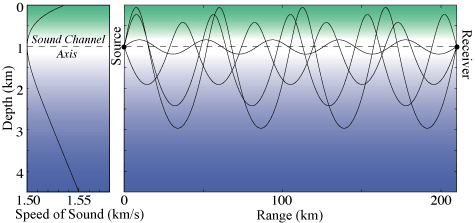Tutorial: Sound Channel
It is important to understand that the way sound travels is very much dependent on the conditions of the ocean. The sound speed minimum at roughly 1000 meter depth in mid-latitudes creates a sound channel that lets sound travel long distances in the ocean.
Sound is refracted just as light is. Refraction occurs not only when light moves from water to air, but whenever the speed of light changes. Similarly, a sound wave traveling through the ocean is bent whenever it encounters changes in the speed of sound. Since sound speed changes with changes in temperature, salinity, and pressure, a sound wave will refract as it moves through the ocean.
A sound channel exists in the ocean that allows low-frequency sound to travel great distances. This channel is called the SOund Fixing And Ranging , or SOFAR, channel.

There is a minimum in sound speed at a depth of roughly 1000 m in mid-latitudes. Sound speed near the surface decreases with increasing depth due to decreasing temperature. The sound speed at the surface is fast because the ocean is warmed by the sun heating the upper layers of the ocean. As the depth increases, the water temperature gets colder and colder until it reaches a nearly constant value of about 2°C for depths below roughly 1000 m. Where temperature is nearly constant, the pressure of the water has the largest effect on sound speed. Because pressure increases with depth, sound speed increases with depth. Salinity has a much smaller effect on sound speed than temperature or pressure at most locations in the ocean. This is because the effect of salinity on sound speed is small and salinity changes in the open ocean are also small.

Profile of speed of sound in water. Note the sound speed minimum at 1000 meters. Copyright University of Rhode Island.